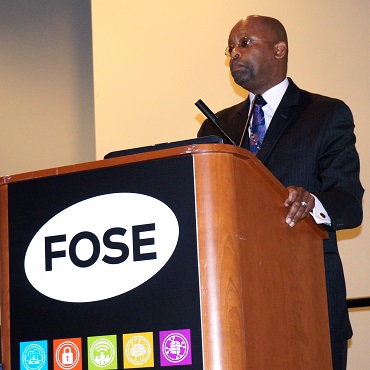News and notes from day 2 at FOSE
Highlights from the second day of the FOSE conference.

During a panel discussion at the FOSE conference, FEMA's Adrian Gardner said low-tech tools are often more effective in disaster situations than their high-tech counterparts.
Why federal IT execs need to answer to a higher authority
When Rich Beutel, a senior House staffer and procurement policy expert, was gathering background input for the Federal IT Acquisition Reform Act, he met separately with division CIOs at the same large agency (he did not say which) who were working on parallel but unconnected projects to build databases to manage the spare parts inventory for small fleets of aircraft. One project cost $60 million, and another cost $30 million. Beutel recalls asking one of the CIOs why the projects couldn't be combined, and the CIO replied, "We can't possibly use theirs. They have jets. We have turboprops."
Beutel, senior adviser and counsel for acquisition policy at the House Oversight and Government Reform Committee and a 2014 Federal 100 winner, said the anecdote illustrates why there needs to be a single "chief" at federal agencies, with visibility and responsibility for IT across bureaus at highly federated government departments.
"From the program management perspective, CIOs need broader, enhanced authorities," Beutel said during a keynote speech at FOSE.
FITARA, which would expand the authority of agency-level CIOs and make the position a presidential appointment, has passed the House twice, most recently in February, and is awaiting action in the Senate. The bill also contains provisions to spread best practices for IT acquisition across the government, develop requirements for acquiring commodity IT and introduce a program to allow for broader flexibility in IT spending than is typically allowed under the appropriations process.
It is not clear what path FITARA will take in the Senate. The Homeland Security and Governmental Affairs Committee has passed a related bill on data center consolidation, which has been added to the Senate calendar and could be offered for passage under unanimous consent in the coming weeks. (FITARA has its own section on data center optimization.)
It is conceivable that pieces of FITARA could be added to the Senate data center bill before it is brought to the floor, or some pieces of FITARA could be added when the Senate bill is considered in the House. Alternatively, the defense authorization bill could serve as a vehicle for FITARA legislation, which lawmakers tried to do in 2013.
Low-tech often best in disaster situations
In the wake of weather disasters, earthquakes and other crisis situations, first responders are often best served by older, sturdier technologies, Federal Emergency Management Agency CIO Adrian Gardner said during a FOSE panel discussion on May 14.
"Imagine 30 people trying to make a decision while standing around looking at a map on the same iPad or the same computer," he said. While geographic information system developers might consider paper maps to be passé, sometimes they offer the best utility in a field situation, Gardner said.
The same goes for communications. The last mile of cellular and wired networks in remote locations can be the first channel to do down in a disaster. Having multiple providers isn't necessarily a solution because they might rely on the same network infrastructure.
Gardner said sometimes old-fashioned ham radio can be the best tool to establish communications in crisis situations, and FEMA is concerned that there are fewer skilled radio hobbyists to pitch in as volunteers when disasters strike.
Soft and hard costs of the cloud
One part of a federal CIO's job is to appear before Congress to prove that IT initiatives are saving the taxpayers money.
But when it comes to the cloud, not all costs are easily measured or proven. Agencies face challenges in quantifying those soft costs.
"Most agencies can't tell how much it costs to run their data or how much their data centers cost -- the electricity, power, water cooling, etc. It's not a line item on their budget," said Susie Adams, chief technology officer for Microsoft Federal's civilian business, during a panel discussion on cloud computing on May 13. "For many federal agencies, it looks like you have to pay money to save money."
Even as federal IT budgets remain generally flat, spending on cloud computing is expected to rise because it is seen as a method of cutting costs. In the proposed $80 billion IT budget for fiscal 2015, $20 billion would be dedicated to cloud systems.
Panel moderator Shawn Kingsberry, CIO at the Recovery Accountability and Transparency Board, said his agency -- the first to move to a government cloud -- claimed savings of $750,000.
As vendors' cloud prices continue to drop, it indicates a larger trend of increased use and success of cloud in government, said Doug VanDyke, general manager for civilian government at Amazon.
"What we're seeing with cloud is when you build a large infrastructure, you can provide services at a lower cost, and in turn, you get more customers," VanDyke said. "When you get more customers, you create more efficiencies. Those efficiencies at scale are what make prices drop."


